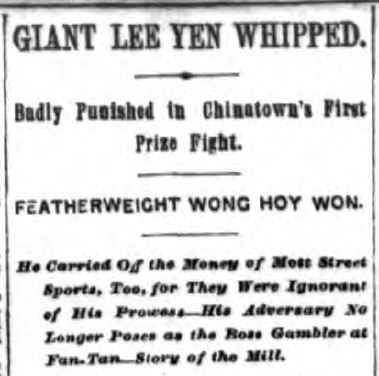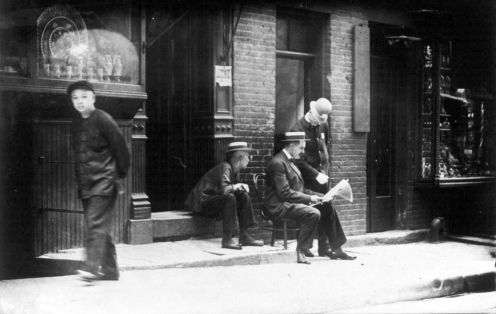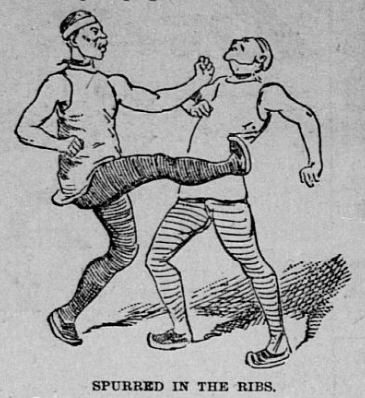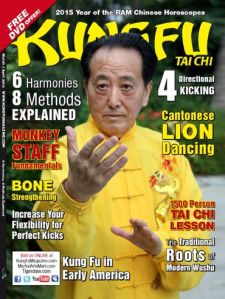First Report of a Bare-Knuckle Kung Fu Contest in New York City’s Chinatown, 1891
Only one year after the first exhibition of Kung Fu in America, on January 18, 1891, the following headline graced the columns of the New York World:
This brutal contest took place in a Chinese grocery at 23 Pell Street, and was fought between laundrymen Wong Hoy and Lee Yen, for a purse of twenty dollars. By all accounts, it was a case of David versus Goliath. Yen was described as a six-foot-two “giant” weighing 225 pounds, and one who had accomplished many “wonderful feats of strength.” Hoy, on the other hand, was five-foot-three, exhibited a “consumptive look,” and weighed 120 pounds. However, it was noted that Hoy had “a record of many victories in Philadelphia and Boston.” Regarding the conditions, it was noted:
“Chinese rules were to govern….there is no ring marked off at all. Combatants may kick, punch, claw, bite, wrestle, jump upon each other or dig each other’s eyes out. Weapons alone are barred.”
The World elaborated,
“The gentlemanly knockdowns, clinches, dodging and racing around the ring to avoid punishment which constitute a fight under Marquis of Queensberry rules are looked upon with disdain by these Orientals. There could be a mill in Chinatown seven nights of the week and no opportunity would ever be offered for disputes among the backers. ‘Everything goes,’ and there can be no foul. The battle is not won until one of the bruisers is a temporary corpse. Until knocked insensible he is not allowed to throw up the sponge.”
Just before 8:30 PM, the grocery began to fill with Chinese sporting types, most of whom placed their bets on the larger fighter. The two combatants stepped forward, attended by their seconds, and then began, according to the World, “the first prize fight in the history of Mott street.”
“Lee opened with a tremendous kick…Without a moment’s delay Wong dodged behind the giant and administered a terrible kick in the small of the back. Then he buried his sharp claws into Lee’s face, and rained kick after kick upon his body in rapid succession. Before the big fellow knew what had hit him Wong released his hold, dived under [Lee’s] legs and beautifully threw him. The bulky mass…dropped like a log, head first.”
A “jumping match” then ensued, with Wong Hoy on top. After jumping on Lee Yen three times, Hoy “dug his long finger-nails into Lee’s face and opened pores of his skin in many places, causing the beautiful crimson to flow. A few more kicks and a jump or two for good measure and Lee’s senses had flown.” It was noted,
“There could only be one decision, and when the referee recovered his breath he ordered stakes turned over to the victor. …. Everybody except Wong had bet the wrong way and that individual had everybody’s money. With the same saucey smile the Hartford prodigy asked pleasantly whether there happened to be any one in the crowd who thought he knew how to carry himself scientifically. None volunteered.”
Hoy was thus celebrated throughout New York’s Chinatown.
American newspapers reacted with universal horror toward these contests. In his account of the Pell Street contest, a disturbed reporter from the Rome Daily Sentinel pontificated,
“Such is Chinese pugilism, and its essential features, if adopted in the American prize ring, would doubtless relieve the community of its pugilists. What feather, middle or heavy weight could stand such tactics as those allowed in the case of Wong Hoy and Lee Yen?”
NOTE: A greatly expanded version of this article, covering other Kung Fu contests and practitioners of the same period, appears in the 2015 March/April issue of Kung Fu Magazine, under the title Kung Fu in Early America.






Trackbacks & Pingbacks